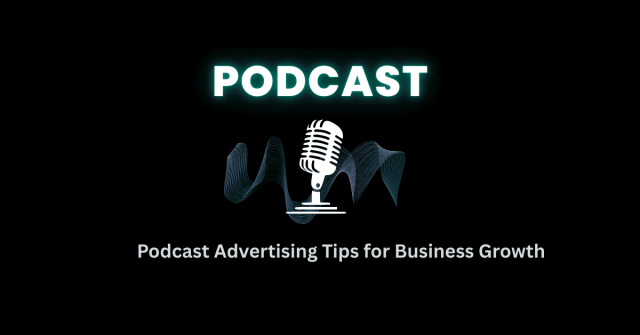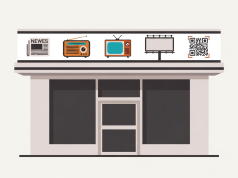Podcast advertising leverages trusted host-listener relationships to deliver highly engaging, targeted audio ads. By choosing the right shows, crafting compelling messages, and tracking performance, brands can boost awareness, drive conversions, and connect authentically with loyal podcast audiences.
The podcasting industry has exploded into a $2 billion advertising market, and savvy marketers are taking notice. With over 464 million podcast listeners worldwide and growing engagement rates that outperform traditional media, podcast advertising offers brands an unprecedented opportunity to connect with highly engaged, loyal audiences.
But podcast advertising isn’t just about buying ad slots and hoping for the best. Success requires understanding the unique dynamics of audio marketing, choosing the right shows for your brand, and crafting messages that resonate with podcast audiences. Whether you’re a marketing manager exploring new channels or a business owner looking to expand your reach, this guide will walk you through everything you need to know about podcast advertising.
From understanding different ad formats to measuring campaign success, you’ll discover how to leverage the intimacy and trust that podcasts create between hosts and listeners—and turn that connection into meaningful results for your business.
Why Podcast Advertising Works
Podcast advertising succeeds where other formats struggle because of the unique relationship between hosts and their audiences. Unlike banner ads or social media promotions that viewers actively ignore, podcast ads benefit from the trust and intimacy that develops through regular listening.
In many ways, podcast advertising builds on the strengths of traditional radio marketing, but with even greater personalization and targeting. While radio has long been known for its ability to reach local, engaged audiences, podcasts take that model further—allowing advertisers to reach niche listener segments across the globe, often in a more on-demand and distraction-free environment.
Research shows that 54% of podcast listeners are more likely to consider brands they hear advertised on their favorite shows. This consideration stems from what marketers call the “endorsement effect”—when trusted hosts personally deliver ad messages, listeners perceive them as recommendations rather than interruptions.
The demographics also work in advertisers’ favor. Podcast audiences tend to be educated, affluent, and digitally savvy. According to Edison Research, 49% of podcast listeners have household incomes above $75,000, and 27% hold college degrees. These listeners actively engage with podcast content, often subscribing to multiple shows and listening to entire episodes.
Perhaps most importantly, podcast advertising offers something increasingly rare: undivided attention. While people multitask during TV commercials or scroll past digital ads, podcast listeners typically engage in complementary activities like commuting, exercising, or doing household tasks—activities that don’t compete with audio content for attention.
Types of Podcast Ads
Understanding the three main podcast advertising formats helps you choose the approach that best fits your goals and budget.
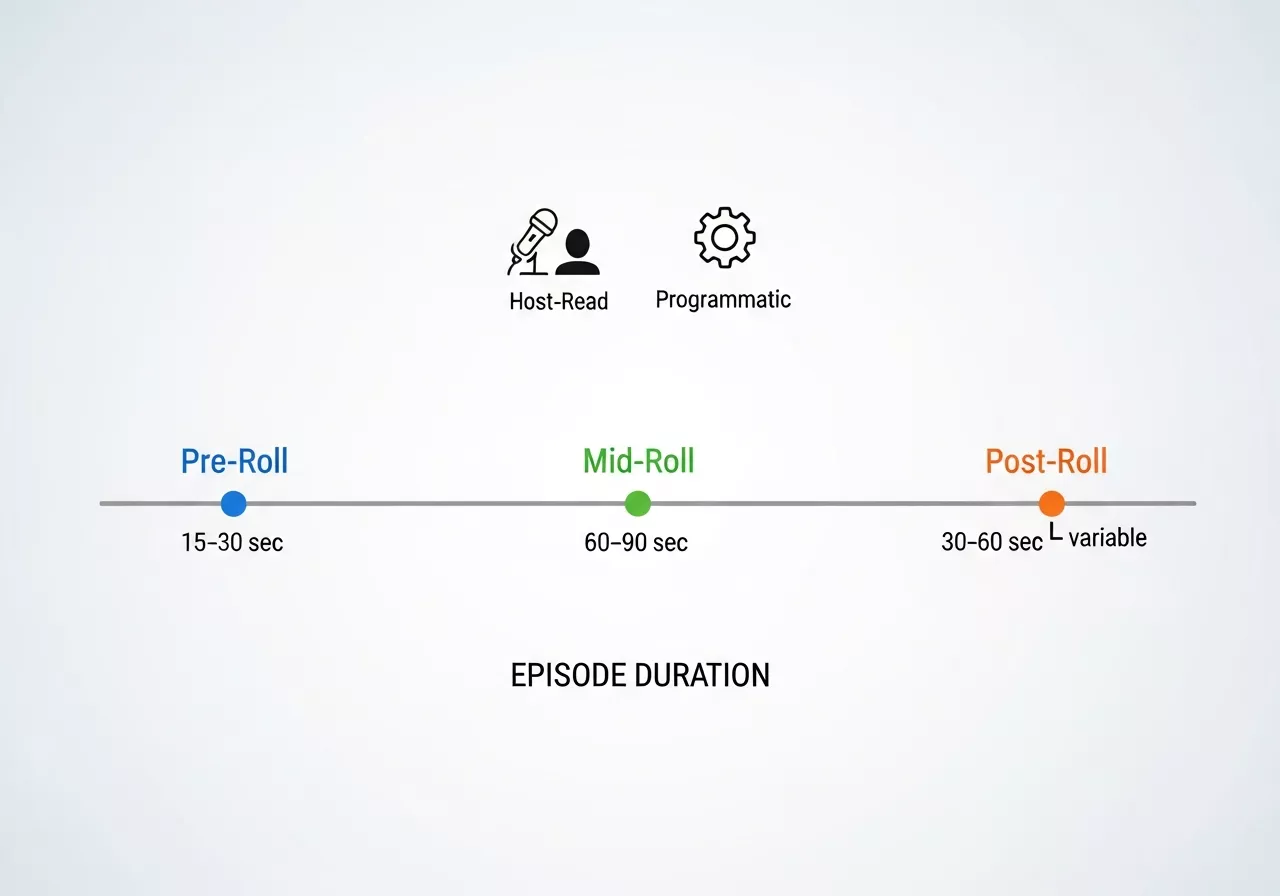
Pre-Roll Ads
Pre-roll ads play at the beginning of podcast episodes, typically lasting 15-30 seconds. These brief spots work well for brand awareness campaigns and direct response offers that don’t require extensive explanation. Since listeners haven’t yet invested time in the episode content, pre-roll ads need to grab attention quickly and deliver value propositions clearly.
The main advantage of pre-roll advertising lies in guaranteed exposure—every listener who starts the episode hears your message. However, some listeners may skip forward or abandon episodes during pre-roll segments, particularly if ads feel irrelevant or overly promotional.
Mid-Roll Ads
Mid-roll ads appear during natural breaks in podcast content, usually lasting 60-90 seconds. These placements command premium pricing because they capture listeners when engagement peaks. By the time mid-roll ads play, audiences have already invested in the episode and are less likely to skip ahead.
Mid-roll spots allow for more detailed storytelling and complex value propositions. Many successful mid-roll campaigns incorporate narrative elements that mirror the podcast’s style, creating seamless transitions between content and advertising.
Post-Roll Ads
Post-roll ads play at episode endings, after the main content concludes. These placements cost less than mid-roll spots but may reach smaller audiences, as some listeners stop playback before episodes finish completely.
Despite lower completion rates, post-roll ads can be highly effective for specific goals. Listeners who stay until the end demonstrate high engagement levels and may be more receptive to longer-form advertising messages or detailed calls-to-action.
Host-Read vs. Programmatic Ads
Beyond placement timing, podcast ads differ in delivery method. Host-read ads feature show hosts personally delivering advertiser messages, often in their own words and style. These authentic endorsements typically outperform scripted alternatives but require more coordination and cost more to produce.
Programmatic ads use automated insertion technology to place pre-recorded messages into podcast episodes. While less personal than host-read content, programmatic advertising offers greater scale, precise targeting options, and real-time optimization capabilities.
Choosing the Right Podcasts for Your Brand
Successful podcast advertising starts with selecting shows that align with your brand values and reach your target audience. Rather than simply chasing large listener numbers, focus on finding podcasts where your message will resonate authentically.
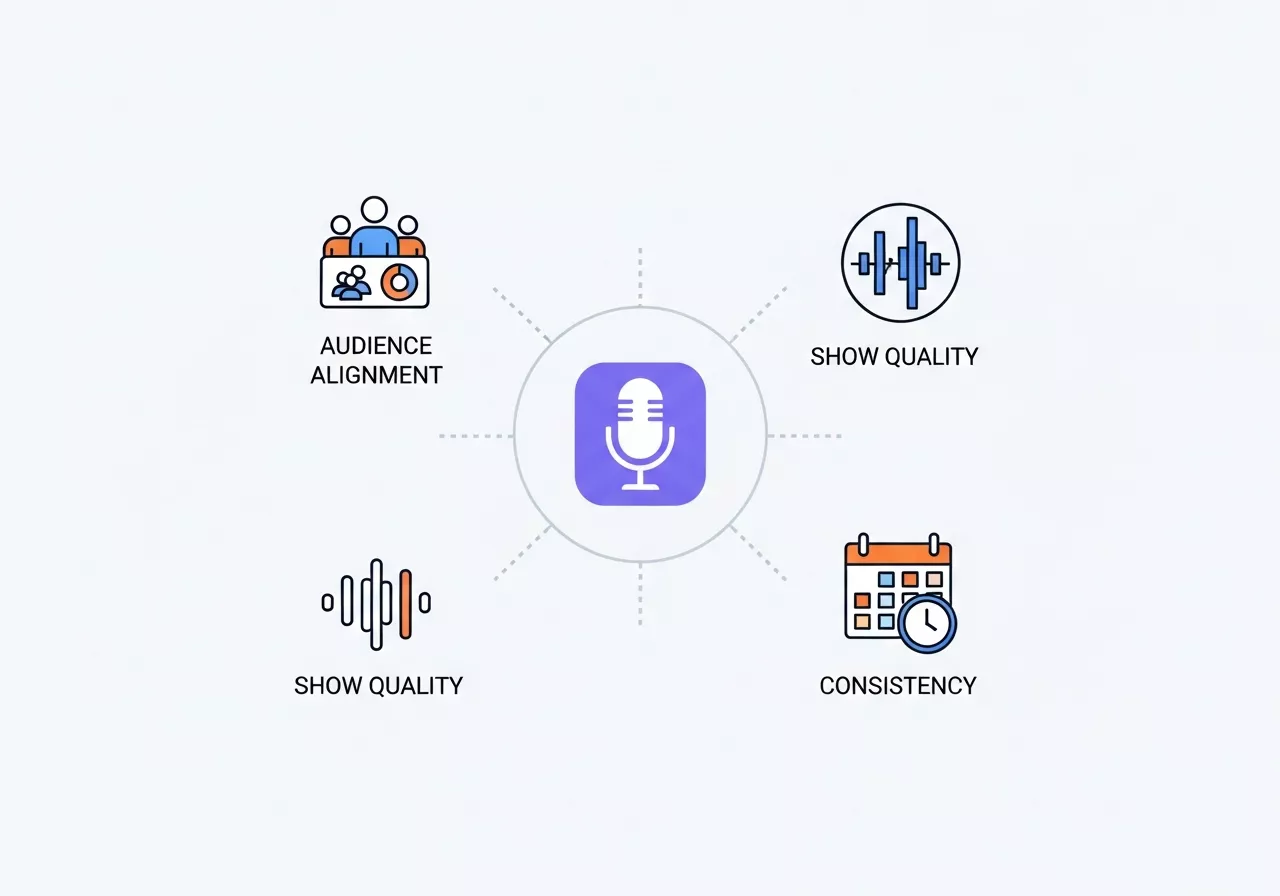
Audience Alignment
Begin by analyzing podcast demographics and psychographics. Most established podcasts provide media kits that include listener data such as age ranges, gender splits, income levels, and geographic distribution. However, dig deeper than surface-level demographics to understand audience interests, values, and behaviors.
Consider whether podcast topics naturally connect to your product or service. A meditation app might find success advertising on wellness podcasts, while a project management tool could perform well on business and entrepreneurship shows. The connection doesn’t need to be obvious, but it should make logical sense to listeners.
Show Quality and Consistency
Evaluate podcast production quality, release schedules, and host professionalism. High-quality audio, consistent publishing schedules, and professional presentation reflect positively on advertiser brands. Shows with erratic posting schedules or poor audio quality may indicate operational challenges that could affect campaign performance.
Review several recent episodes to understand the show’s tone, host personality, and typical content themes. Ensure that podcast values align with your brand positioning. An irreverent comedy podcast might not suit a conservative financial services company, regardless of audience demographics.
Engagement Metrics
Look beyond download numbers to assess genuine engagement levels. Review podcast ratings, comment sections, and social media activity to gauge how actively audiences interact with show content. High engagement often translates to better advertising performance, even when total listener numbers are smaller.
Many podcasts share engagement data, including average listen duration, episode completion rates, and social media metrics. These indicators provide better insight into audience quality than raw download statistics alone.
Creating Effective Podcast Ad Content
Podcast advertising content must feel native to the audio medium while clearly communicating brand messages. The most successful campaigns balance entertainment value with commercial objectives, creating ads that listeners actually want to hear.
Incorporating elements from social media viral trends can make ads more relatable and timely. Referencing popular memes, challenges, or trending discussions within your ad script allows your message to feel current and culturally relevant, helping it resonate with listeners who are also active on social platforms.

Know Your Audience Context
Consider when and where people typically listen to your chosen podcasts. Commuting audiences might respond well to convenience-focused messages, while gym listeners could prefer energetic, motivational content. Match your ad tone and energy to the listening environment and mindset.
Understanding podcast content themes also informs effective messaging. Business podcasts attract goal-oriented listeners who appreciate efficiency and results, while entertainment shows reach audiences seeking humor and personality. Adapt your brand voice to complement these different contexts.
Lead with Value
Start podcast ads with clear value propositions rather than brand names or generic introductions. Listeners decide within seconds whether to pay attention or mentally tune out. Opening with compelling benefits or intriguing questions increases the likelihood of capturing and maintaining audience attention.
For example, instead of “Hi, this is Sarah from TechCorp,” try “What if you could cut your project management time in half?” This approach immediately signals value and relevance to listeners while creating curiosity about your solution.
Include Clear Calls-to-Action
Every podcast ad needs a specific, memorable call-to-action that guides listeners toward desired behaviors. Since podcast audiences can’t immediately click or tap like digital media users, your calls-to-action must be simple enough to remember and act upon later.
Use custom URLs, promo codes, or phone numbers that track back to podcast campaigns. Make these elements easy to spell and remember—avoid complex URLs or lengthy promo codes that listeners might forget before they can act on them.
Test Different Approaches
Create multiple ad versions to test different messaging approaches, lengths, and calls-to-action. A/B testing reveals which elements resonate most strongly with specific podcast audiences. Some shows respond better to conversational, story-driven ads, while others prefer direct, benefit-focused messaging.
Track performance metrics for each variation to identify patterns across different podcasts and audience segments. This data informs future campaign optimizations and helps refine your podcast advertising strategy over time.
Measuring Podcast Advertising Success
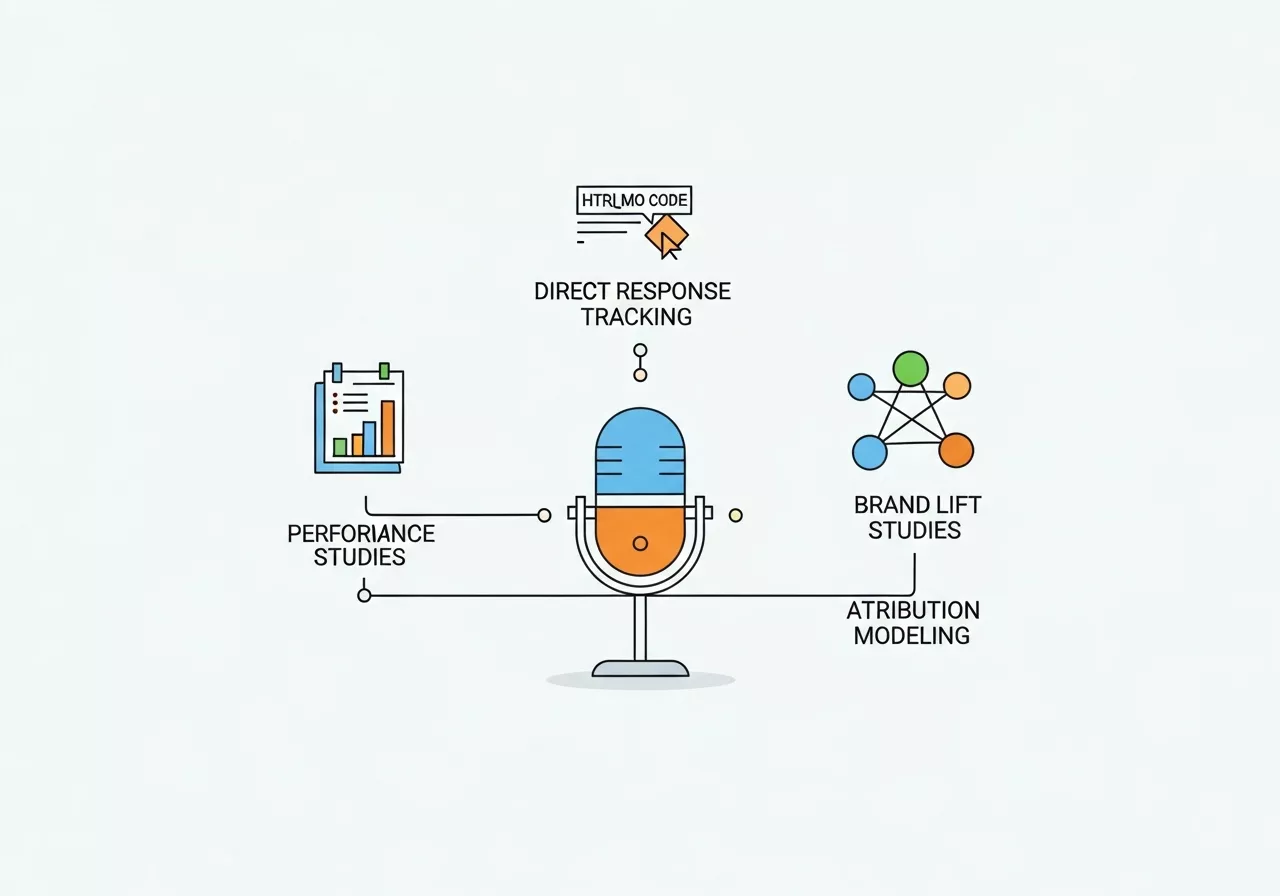
Measuring podcast advertising effectiveness requires a combination of direct response tracking, brand awareness studies, and attribution modeling. Unlike digital channels with immediate click-through data, podcast measurement often involves longer attribution windows and multiple touchpoints.
Brands with experience in traditional advertising strategy can leverage the same principles—audience targeting, creative testing, and ROI tracking—to ensure their podcast campaigns are not just creative but measurable and aligned with broader marketing objectives.
Direct Response Tracking
Use unique promo codes, custom URLs, and dedicated phone numbers to track immediate responses to podcast ads. These attribution methods provide clear connections between specific campaigns and resulting conversions, making it easier to calculate return on advertising spend.
Create separate tracking mechanisms for each podcast placement to understand which shows drive the strongest response rates. This granular data helps optimize future media buying decisions and budget allocation across different podcasts.
Brand Lift Studies
Conduct surveys to measure brand awareness, consideration, and purchase intent changes among podcast audiences. Brand lift studies capture advertising impact that doesn’t immediately convert to direct response metrics but influences future purchasing decisions.
Partner with research firms that specialize in audio advertising measurement, or use platforms that offer built-in brand lift tracking capabilities. These studies provide valuable insight into the upper-funnel marketing impact that direct response tracking might miss.
Attribution Modeling
Implement multi-touch attribution models that account for podcast advertising’s role in longer customer journeys. Many podcast listeners research products across multiple channels before making purchase decisions, requiring sophisticated tracking to properly credit podcast touchpoints.
Use UTM parameters, pixel tracking, and customer surveys to build comprehensive pictures of how podcast advertising contributes to overall marketing performance. This holistic approach provides more accurate ROI calculations and informs strategic budget allocation decisions.
Getting Started with Your First Campaign
Ready to launch your podcast advertising journey? Start small, test thoroughly, and scale based on results. Your first campaign should focus on learning and optimization rather than massive reach.
Just as trade show marketing allows brands to engage audiences face-to-face and generate leads in a highly targeted environment, podcast advertising provides an audio equivalent: direct access to highly engaged, niche audiences. Both strategies benefit from thoughtful planning, tailored messaging, and clear calls-to-action to maximize ROI.
Choose two to three podcasts that strongly align with your target audience and brand values. Starting with fewer shows allows for more hands-on campaign management and clearer performance attribution. You can always expand successful campaigns to additional podcasts once you understand what works.
Set aside time for campaign planning, creative development, and performance monitoring. Podcast advertising succeeds through attention to detail and continuous optimization, not set-and-forget approaches.
Work with experienced podcast advertising agencies or platforms if the budget allows. These partners bring valuable industry knowledge, established host relationships, and sophisticated measurement capabilities that can accelerate your learning curve and improve initial campaign performance.
The podcasting landscape continues evolving rapidly, creating new opportunities for creative, strategic advertisers. By understanding audience dynamics, crafting compelling content, and measuring results systematically, your brand can tap into the powerful connection between podcasts and their loyal listeners.
FAQ: Podcast Advertising
1. What is podcast advertising?
Podcast advertising is promoting products or services through audio ads within podcast episodes. It leverages the trust and engagement between hosts and listeners to reach highly targeted audiences effectively.
2. Why is podcast advertising effective?
Listeners often develop strong connections with hosts, making host-read ads feel like personal recommendations. Podcasts also allow for undivided attention, niche targeting, and high engagement compared to traditional or digital ads.
3. What types of podcast ads are there?
- Pre-roll: 15–30 seconds at the episode start, great for quick brand awareness.
- Mid-roll: 60–90 seconds during episodes, high engagement and storytelling-friendly.
- Post-roll: After content ends, usually lower cost but smaller audience reach.
4. What’s the difference between host-read and programmatic ads?
- Host-read ads: Delivered by the host, personal and authentic, often more effective.
- Programmatic ads: Automated insertion, scalable with precise targeting, less personal.
5. How do I choose the right podcasts for my brand?
Look for shows with audiences that align with your target demographics and interests. Evaluate engagement metrics, production quality, host credibility, and content relevance to your brand.
6. How do I create effective podcast ads?
- Match your ad tone to listener context and show theme.
- Lead with value rather than just the brand name.
- Include clear, memorable calls-to-action (promo codes, URLs).
- Test multiple ad versions to optimize performance.
7. How is podcast advertising performance measured?
- Direct response tracking: Promo codes, custom URLs, dedicated phone numbers.
- Brand lift studies: Surveys to measure awareness and consideration.
- Attribution modeling: Multi-touch tracking to assess podcast impact within the customer journey.
8. How much does podcast advertising cost?
Costs vary by ad format, audience size, and host reputation. Mid-roll ads command higher prices, while pre- and post-roll ads are generally more affordable. Programmatic ads offer scalable pricing options.
9. Can small businesses benefit from podcast advertising?
Yes. Targeting niche podcasts with aligned audiences allows small businesses to maximize impact and ROI without needing massive budgets. Starting with a few shows for testing is recommended.
10. How do I get started with my first campaign?
- Select 2–3 aligned podcasts.
- Develop creative, contextually relevant ads.
- Track performance with custom codes or URLs.
- Test, optimize, and scale campaigns gradually.
Learn about: Traditional Marketing for Small Business: Strategies That Work

